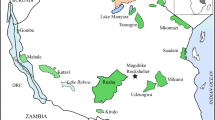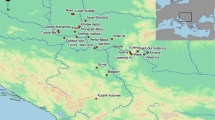Abstract
More than ten thousands of bone fragments were recovered from the Lingjing site, Henan Province during 2005 and 2006. In this paper, through the quantification and statistical analyses of the skeletal elements of the two predominant species in this assemblage, aurochs (Bos primigenius) and horse (Equus caballus), the differential influences and weights of a variety of taphonomic agencies in the formation of the assemblage are assessed respectively. Compared to the natural agencies, hominid hunting and the subsequent disarticulation, slaughtering, and their transport of the bone elements of the prey species are the main factors accounting for the formation of the present assemblage. More importantly, this study initiatively identifies hominid’s differential treatment of the bones of aurochs and horse in the Paleolithic record of East Asia and demonstrably suggests that hominids at the site have already practiced sophisticated hunting techniques and subsistence strategies and may be quite familiar with the ecological and anatomical characteristics and nutritional values of the large-sized prey animals and can accordingly take different processing and handling strategies at the hunting site.
Similar content being viewed by others
References
Perkins J D, Daly P. A hunters’ village in Neolithic Turkey. Sci Am, 1968, 219: 97–106
Binford L R. Nunamiut Ethnoarchaeology. New York: Academic Press, 1978
Binford L R. Bones: Ancient Men and Modern Myths. New York: Academic Press, 1981
Metcalfe D, Jones K T. A reconsideration of animal body-part utility indices. Am Antiq, 1988, 53: 486–504
Li Z Y. A primary study on the stone artefacts of Lingjing site excavated in 2005 (in Chinese). Acta Anthropol Sin, 2007, 26: 138–154
Li Z Y, Dong W. Mammalian fauna from the Lingjing Paleolithic Site in Xuchang, Henna Province (in Chinese). Acta Archaeol Sin, 2007, 26: 345–360
Zhang S Q. Taphonomic study of the faunal remains from the Lingjing Site, Xuchang, Henan Province (in Chinese). Dissertation for the Doctoral Degree. Beijing: Institute of Vertebrate Paleontology and Paleoanthropology, the Chinese Academy of Sciences, 2009. 1–216
Gao X, Norton C J. A critique of the Chinese “Middle Palaeolithic”. Antiquity, 2002, 76: 397–412
Norton C J, Gao X, Feng X W. The East Asian middle paleolithic reexamined. In: Camps M, Chauhan P R, eds. Sourcebook of Paleolithic Transitions: Methods, Theories, and Interpretations. New York: Springer, 2010. 245–254
White T E. Observations on the butchering technique of some aboriginal peoples, J. Am Antiq, 1952, 17: 337–338
Dominguez-Rodrigo M. Hunting and scavenging by early humans: The state of the debate. J World Prehist, 2002, 16: 1–56
Stiner M C. Honor Among Thieves. Princeton: Princeton University Press, 1994
Stiner M C. The Faunas of Hayonim Cave (Israel): A 200000-Year Record of Paleolithic Diet, Demography and Society. Cambridge: Peabody Museum Press, 2005
Lyman R L. Vertebrate Taphonomy. Cambridge: Cambridge University Press, 1994
Gifford D P. Taphonomy and paleoecology: A critical review of archaeology’s sister disciplines. In: Schiffer M B, ed. Advances in Archaeological Method and Theory, Vol. 4. New York and London: Academic Press, 1981. 365–438
Fiorillo A R. An experimental study of trampling: Implications for the fossil record. In: Bonnichsen R, Sorg M H, eds. Bone Modification. Orono: University of Maine Center for the Study of the First Americans, 1989. 61–72
Voorhies M. Taphonomy and Population Dynamics of an Early Pliocene Vertebrate Fauna, Knox County, Nebraska. University of Wyoming Contributions to Geology, Special Paper, No.1, Laramie, 1969
Behrensmeyer A K. The taphonomy and paleoecology of Plio-Pleistocene vertebrate assemblages East of Lake Rudolf, Kenya. Bull Mus Comp Zool, 1975, 145: 473–574
Myers T S, Storrs G W. Taphonomy of the Mother’s Day Quarry, Upper Jurassic Morrison Formation, South-Central Montana, USA. PALAIOS, 2007, 22: 651–666
Marean C W. Measuring the post-depositional destruction of bone in archaeological assembalges. J Archaeol Sci, 1991, 18: 677–694
Emerson A M. Archaeological implications of variability in the economic anatomy of bison bison. Dissertation for the Doctoral Degree. New York: Washington State University, 1990
Norton C J, Zhang S Q, Zhang Y, et al. Distinguishing Hominin and Carnivore signatures in the Plio-Pleistocene faunal record. Acta Archaeol Sin, 2007, 26: 183–192
Dominguez-Rodrigo M. Meat-eating by early hominids at the FLK 22 Zinjanthropus site, Olduvai Gorge, Tanzania: An experimental approach using cut mark data. J Hum Evol, 2000, 1997, 33: 669–690
Dominguez-Rodrigo M. Flesh availability and bone modification in carcasses consumed by lions. Palaeogeogr Palaeoclimatol Palaeoecol, 1999, 149: 373–388
Norton C J, Gao X. Hominin-carnivore interactions during the Chinese Early Paleolithic: Taphonomic perspectives from Xujiayao. J Hum Evol, 2008, 55: 164–178
Zhang S Q, Li Z Y, Zhang Y, et al. Mortality profiles of the large herbivores from the Lingjing Xuchang Man Site, Henan Province and the early emergence of the modern human behaviors in East Asia. Chin Sci Bull, 2009, 54: 2857–2863
Paola Villa, Jean-Christophe Castel, Cédric Beauval, et al. Human and carnivore sites in the European Middle and Upper Paleolithic: Similarities and differences in bone modification and fragmentation. Revue Paléobiol, 2004, 23: 705–730
Lam Y M, Chen X B, Pearson O M. Intertaxonomic variability in patterns of bone density and the differential representation of bovid, cervid, and equid elements in the archaeological record. Am Antiq, 1999, 64: 343–362
Stopp M P. Taphonomic analysis of the faunal assemblage. In: Singer R, Wymer J J, Gladfelter B G, eds. The Lower Paleolithic Site at Hoxne, England. Chicago: University of Chicago, 1993. 138–149
Chase P G. The hunters of Combe Grenal: Approaches to Middle Paleolithic subsistence in Europe. BAR International Series 286. Oxford: British Archaeological Reports, 1986
Klein R G, Cruz-Uribe K. The Paleolithic mammalian fauna from the 1910–14 excavations at EI Castillo Cave (Cantabria). Centro de Investigaciony Museo de Altamira Monografias, 1994, 17: 141–158
Klein R G. Reconstructing how early people exploited animals: problems and prospects. In: Nitecki M H, Nitecki D V, eds. The Evolution of Human Hunting. New York: Plenum Press, 1987. 11–45
Boyle K V. Upper palaeolithic procurement and processing strategies in Southwest France. In: Peterkin G L, Bricker H M, Mellars P, eds. Hunting and Animal Exploitation in the Later Palaeolithic and Mesolithic of Eurasia. Archaeol Pap Amer Anthropol Assoc, 1993, 4: 151–162
Villa P, Bartram L. Flaked bone from a hyena den. Paléo, 1996, 8: 143–159
Gifford-Gonzalez D P. Ethnographic analogues for interpreting modified bones: Some cases from East African. In: Bonnichsen R, Sorg M H, eds. Bone Modification. Orono: University of Maine Center for the Study of the First Americans, 1989. 179–246
Shipman R. Life History of a Fossil: An Introduction to Taphonomy and Paleoecology. Cambridge: Harvard University Press, 1981
Blumenschine R L, Madrigal T C. Variability in long bone marrow yields of East African Ungulates and its zooarchaeological implications. J Archaeol Sci, 1993, 20: 555–587
Outram A K. A new approach to identifying bone marrow and grease exploitation: Why the “indeterminate” fragments should not be ignored. J Archaeol Sci, 2001, 28: 401–410
Zedda M, Lepore G, Manca P, et al. Comparative bone histology of adult horses (Equus caballus) and cows (Bos taurus). Anat Histol Embryol, 2008, 37: 442–445
Bunn H T. Bone assemblages at base camps: A further consideration of Carcass transport and bone destruction by the hadza. In: Hudson L, ed. From Bones to Behavior: Ethnoarchaeological and Experimental Contributions to the Interpretation of Faunal Remains. Illinois: Center for Archaeological Investigations, 1993. 156–168
Monahan C M. The Hadza carcass transport debate revisited and its archaeological implications. J Archaeol Sci, 1998, 25: 405–424
Oliver J S. Carcass processing by the hadza: Bone breakage from butchery to consumption. In: Hudson L, ed. From Bones to Behavior: Ethnoarchaeological and Experimental Contributions to the Interpretation of Faunal Remains. Illinois: Center for Archaeological Investigations, 1993. 200–227
Levine M A. Eating horses: The evolutionary significance of Hippophagy. Antiquity, 1998, 72: 90–100
Dominguez-Rodrigo M. Conceptual premises in experimental design and their bearing on the use of analogy: An example from experiments on cut marks. World Archaeol, 2008, 40: 67–82
Lupo K D. What explains the carcass field processing and transport decisions of contemporary hunter-gatherers? Measures of economic anatomy and zooarchaeological skeletal part representation. J Archaeol Method Th, 2006, 13: 9–66
Author information
Authors and Affiliations
Corresponding author
Rights and permissions
About this article
Cite this article
Zhang, S., Li, Z., Zhang, Y. et al. Skeletal element distributions of the large herbivores from the Lingjing site, Henan Province, China. Sci. China Earth Sci. 55, 246–253 (2012). https://doi.org/10.1007/s11430-011-4279-x
Received:
Accepted:
Published:
Issue Date:
DOI: https://doi.org/10.1007/s11430-011-4279-x




